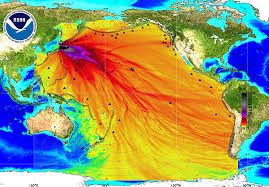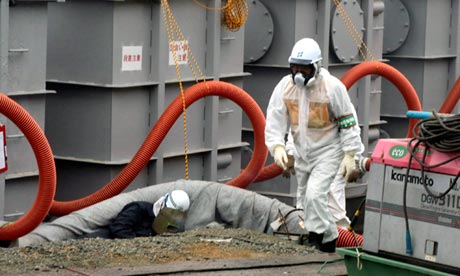
In addition to the storage tank problems and the unending addition of more tanks to capture the radioactive cooling water being pumped in and out of the reactor cores, there are cracks in the floor of the containment buildings leaking radioactive material directly into the Pacific. There are no viable plans to stop these leaks. There is also the impending disaster of the elevated spent fuel rod storage tanks that are at risk of collapsing.
Fukushima radiation levels 18 times higher than previously thought
Operator of Japanese nuclear power plant claims there has been no leak but has yet to discover cause of radiation spike
theguardian.com, Sunday 1 September 2013 05.22 EDT
A Tepco employee in protective clothing works around water tanks at the Fukushima nuclear power plant in June. Photograph: Noboru Hashimoto/EPA
Radiation levels 18 times higher than previously reported have been found near a water storage tank at the Fukushima Daiichi nuclear power plant, causing fresh concern about the safety of the wrecked facility.
The plant's operator, Tokyo Electric Power (Tepco), said radiation near the bottom of the tank measured 1,800 millisieverts an hour – high enough to kill an exposed person in four hours. Tepco said water levels inside the tank had not changed, indicating there had not been a leak. But the company said it had yet to discover the cause of the radiation spike.
Last month Tepco said another storage tank – of the same design as the container causing concern at the weekend – had leaked 300 tonnes of radioactive water, possibly into the sea.
Japan's nuclear watchdog confirmed last week it had raised the severity of that leak from level 1, an "anomaly", to level 3, a "serious incident", on an eight-point scale used by the International Atomic Energy Agency for radiological releases.
Earlier, the utility belatedly confirmed reports that a toxic mixture of groundwater and water being used to cool melted fuel lying deep inside the damaged reactors was seeping into the sea at a rate of about 300 tonnes a day.
Experts said those leaks, which are separate from the most recent incidents, may have started soon after the plant was struck by a powerful tsunami on 11 March 2011.
The tsunami smashed into the plant after Japan's north-east coast was rocked by a magnitude 9.0 earthquake. The waves killed almost 19,000 people, while the resulting triple meltdown at Fukushima Daiichi forced 160,000 people to abandon their homes.
The high radiation levels announced on Sunday highlighted the dangers facing thousands of workers as they attempt to contain, treat and store water safely, while preventing fuel assemblies damaged in the accident from going back into meltdown.
Japan's nuclear workers are allowed an annual accumulative radiation exposure of 50 millisieverts. Tepco said radiation of 230 millisieverts an hour had been measured at another tank, up from 70 millisieverts last month. A third storage tank was emitting 70 millisieverts an hour, Tepco said. Radiation near a pipe connecting two other tanks had been measured at 230 millisieverts.
Tepco admitted recently that only two workers had initially been assigned to check more than 1,000 storage tanks on the site. Neither of the workers carried dosimeters to measure their exposure to radiation, and some inspections had not been properly recorded.
The firm responded to growing criticism of its handling of the water problem by increasing the number of workers patrolling the tanks from the current total of eight to 50.
The firm's inability to safely store contaminated water and prevent more damage to the environment has prompted doubts about its ability to lead the Fukushima Daiichi cleanup. Decommissioning the plant is expected to cost tens of billions of dollars and last around 40 years.
Tepco recently set up a committee to focus on the water leaks and said it would seek advice from foreign decommissioning experts. The prime minister, Shinzo Abe, has said the government will play a bigger role in preventing water contamination.
The chairman of the country's Nuclear Regulation Authority, Shunichi Tanaka, said: "We cannot fully stop contaminated water leaks right away. That's the reality. The water is still leaking in to the sea, and we should better assess its environmental impact."
Tepco's handling of the leaks has drawn an angry response from local fishermen, who had to abandon plans to conduct a trial catch at the end of August. Fishermen south of Fukushima Daiichi have not been able to fish commercially since the disaster, while those north of the plant can catch only octopus and whelks.
"We think that contaminated water management by your company has completely fallen apart," Hiroshi Kishi, chairman of the Japan Fisheries Co-operative, told Tepco's president, Naomi Hirose, during a meeting in Tokyo last week.
"This has dealt an immeasurable blow to the future of Japan's fishing industry, and we are extremely concerned."
The plant's operator, Tokyo Electric Power (Tepco), said radiation near the bottom of the tank measured 1,800 millisieverts an hour – high enough to kill an exposed person in four hours. Tepco said water levels inside the tank had not changed, indicating there had not been a leak. But the company said it had yet to discover the cause of the radiation spike.
Last month Tepco said another storage tank – of the same design as the container causing concern at the weekend – had leaked 300 tonnes of radioactive water, possibly into the sea.
Japan's nuclear watchdog confirmed last week it had raised the severity of that leak from level 1, an "anomaly", to level 3, a "serious incident", on an eight-point scale used by the International Atomic Energy Agency for radiological releases.
Earlier, the utility belatedly confirmed reports that a toxic mixture of groundwater and water being used to cool melted fuel lying deep inside the damaged reactors was seeping into the sea at a rate of about 300 tonnes a day.
Experts said those leaks, which are separate from the most recent incidents, may have started soon after the plant was struck by a powerful tsunami on 11 March 2011.
The tsunami smashed into the plant after Japan's north-east coast was rocked by a magnitude 9.0 earthquake. The waves killed almost 19,000 people, while the resulting triple meltdown at Fukushima Daiichi forced 160,000 people to abandon their homes.
The high radiation levels announced on Sunday highlighted the dangers facing thousands of workers as they attempt to contain, treat and store water safely, while preventing fuel assemblies damaged in the accident from going back into meltdown.
Japan's nuclear workers are allowed an annual accumulative radiation exposure of 50 millisieverts. Tepco said radiation of 230 millisieverts an hour had been measured at another tank, up from 70 millisieverts last month. A third storage tank was emitting 70 millisieverts an hour, Tepco said. Radiation near a pipe connecting two other tanks had been measured at 230 millisieverts.
Tepco admitted recently that only two workers had initially been assigned to check more than 1,000 storage tanks on the site. Neither of the workers carried dosimeters to measure their exposure to radiation, and some inspections had not been properly recorded.
The firm responded to growing criticism of its handling of the water problem by increasing the number of workers patrolling the tanks from the current total of eight to 50.
The firm's inability to safely store contaminated water and prevent more damage to the environment has prompted doubts about its ability to lead the Fukushima Daiichi cleanup. Decommissioning the plant is expected to cost tens of billions of dollars and last around 40 years.
Tepco recently set up a committee to focus on the water leaks and said it would seek advice from foreign decommissioning experts. The prime minister, Shinzo Abe, has said the government will play a bigger role in preventing water contamination.
The chairman of the country's Nuclear Regulation Authority, Shunichi Tanaka, said: "We cannot fully stop contaminated water leaks right away. That's the reality. The water is still leaking in to the sea, and we should better assess its environmental impact."
Tepco's handling of the leaks has drawn an angry response from local fishermen, who had to abandon plans to conduct a trial catch at the end of August. Fishermen south of Fukushima Daiichi have not been able to fish commercially since the disaster, while those north of the plant can catch only octopus and whelks.
"We think that contaminated water management by your company has completely fallen apart," Hiroshi Kishi, chairman of the Japan Fisheries Co-operative, told Tepco's president, Naomi Hirose, during a meeting in Tokyo last week.
"This has dealt an immeasurable blow to the future of Japan's fishing industry, and we are extremely concerned."
No comments:
Post a Comment
Please feel free to comment or make suggestions